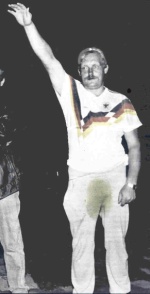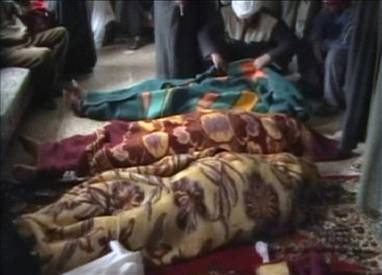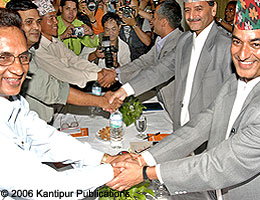본문
The HK based magazine Asia Times published following story 5.26..
North Korea's creepy-crawly capitalism
VLADIVOSTOK, Russia and BANGKOK, Thailand - North Korean capitalism is thriving - just not inside North Korea. Pyongyang has steadily established a string of legitimate and less legitimate front companies across East and Southeast Asia, aimed at earning the cash-strapped government badly needed hard currency. And, by all indications, business is booming.
Consider, for instance, Cafe Pyongyang, one of Vladivostok's most popular eateries. It is so popular, in fact, that there are plans to build a new restaurant in the shape of a North Korean peasant's hut, similar to the one where the late leader Kim Il-sung was born in 1912. Here, gracefully clothed North Korean women serve up traditional Korean fare, while patrons sing popular Korean tunes.
Similarly themed restaurants have popped up in Beijing and Shanghai in China, and Phnom Penh and Siem Reap in Cambodia. But this by no means represents a North Korean business diaspora similar to the ethnic-Chinese community that now controls a large swath of Southeast Asia's economy. Rather, the Pyongyang government owns and operates all of the eateries - and their regional interests reach far beyond restaurants.
North Koreans are becoming skilled capitalists outside their own strict centrally controlled country. For instance, they own a 15-story, 160-room hotel, complete with a nightclub and a sauna, in the northeastern Chinese city of Shenyang. There, government entrepreneurs also run a North Korean-owned computer software company and an Internet service provider. Even more imaginatively, a company in Dandong, a Chinese city just across the Yalu River from North Korea, acquired the exclusive rights to sell North Korean medicines on the international market - including a brand called Cheongchun No 1, a home-made version of Viagra.
Angry enemies, profiting allies
While China is welcoming, North Korean companies have gotten a rise out of Japan and the United States, which contend that Pyongyang uses these concerns sometimes to procure raw materials and dual-use technologies clandestinely to support its missile and nuclear-weapons programs.
Until recently, North Korea was able to acquire sensitive industrial components and chemicals through companies in Japan, which were affiliated with the pro-Pyongyang General Association of Korean Residents, or Chosen Soren. But when the Japanese authorities began to crack down on this trade a few years ago, the North Koreans began buying more goods from Thailand.
In November 2002, a Tokyo-based, Chosen Soren-affiliated company called Meishin - or Myongshin in Korean - attempted to export three power-control devices to North Korea. But when the company informed customs of the planned shipment, Japan's Ministry of Economy, Trade and Industry responded that Meishin required special permission under regulations governing the export of dual-purpose equipment that can be used in, or converted for use in, the production of weapons of mass destruction. The power-control devices could, for instance, be used to stabilize the heavy flow of electric current to uranium-enrichment centrifuges.
Meishin (Myongshin) failed to procure the appropriate documents, but on April 4, 2003, it shipped those same devices to a Thai telecommunications company, Loxley Pacific, which in turn planned to ship them to North Korea's Daesong General Trading Co. But customs in Hong Kong, where the ship stopped on its way to Bangkok, acted on a tip-off from the Japanese, seized the devices and returned them to Japan.
Loxley Pacific has major commercial interests in North Korea, including the operation of a mobile-telephone network, and was a perfect conduit for the stabilizers to North Korea. A Loxley spokesman at the time insisted that the devices were not destined for North Korea's nuclear program.
"The electricity situation is poor in North Korea ... They need stabilizers to avoid hurting their household appliances," he said in a press interview at the time. It is possible, though not altogether likely, that Loxley was unaware of what the dual-use stabilizers were actually intended for.
Thailand, which has cultivated close commercial ties with Pyongyang, recently replaced Japan as North Korea's third-largest trading partner. Two-way trade with Thailand was US$165 million in 2002, rose to $265 million in 2003, and jumped again to $332 million in 2004. In 2005, North Korea imported $207 million worth of goods from Thailand, and exports reached $134 million, or a total two-way trade of $341 million, according to statistics from the Thai Customs Department.
Thailand exports rice, fish, fuel oil, textiles, chemicals and pharmaceuticals to North Korea, while it imports fertilizer, optical equipment, and some iron and steel - at least according to official records. It may seem odd that Thailand, with a well-developed fertilizer industry and as a net fuel importer, would import fertilizer and export fuel oil.
But it seems to indicate off-balance-sheet barter deals, which are famously favored by the North Koreans. In exchange for oil, they give fertilizer to their Thai partners, who, in turn, repackage it using locally produced chemicals of questionable quality, or fertilizers received as aid from South Korea, and sell it at a favorable price to countries such as Laos, Cambodia or Myanmar.
Opaque trade flows
It's exactly that lack of transparency that has North Korea's critics in Washington and Tokyo fuming. North Korea's embassy in Bangkok is its biggest in Southeast Asia, and it operates in conjunction with two locally registered companies, both of which have North Korean citizens listed as directors and allegedly deal in electronics components, ceramics and consumer goods.
The first, Kosun Import Export, was set up in 1991 and operates out of a small apartment block not far from the North Korean Embassy. The other was set up in 1995 and was first called Kotha Supply Import Export, but is now registered as Star Bravo. The company is reported to be a subsidiary of the Daesong Group, which is North Korea's main state-owned trading corporation and the overt arm of Bureau 39, the clandestine foreign-exchange-earning branch of the ruling Korean Workers' Party.
Daesong operates openly under that name in Hong Kong, but no longer in Singapore, where in 2001 it changed its registered name to the more innocuous-sounding Laurich International. In Macau, Daesong was known as Zokwang Trading. But the North Koreans fled the former Portuguese territory last September after the US Treasury Department identified a local bank, Banco Delta Asia, as a "financial institution of primary money-laundering concern". The bank, the US authorities asserted, "has provided services for over 20 years to North Korean government agencies and associated front companies".
The Treasury Department accused "North Korean entities" of being engaged in criminal activities, including the counterfeiting of US currency. The naming of Delta Asia in particular caused depositors to rush the bank and withdraw their holdings. The Macau government had to step in to prevent the bank from collapsing, and Delta Asia finally agreed to dissolve its North Korean links. Subsequently, Zokwang - the first North Korean trading company in the region and active in Macau since the mid-1970s - evacuated its office in the territory and moved its operations to the Zhuhai Special Economic Zone just across the border in mainland China.
The Delta Asia affair has had a snowball effect on everyone doing business with Pyongyang, veritably criminalizing dealing with the regime. Nigel Cowie, the British general manager of the Pyongyang-based Daedong Credit Bank, stated in a speech at an informal meeting hosted by the European Business Association of Pyongyang in the US on May 4: "The result of these actions against banks doing business with the DPRK [Democratic People's Republic of Korea] is that criminal activities go underground and are harder to trace, and legitimate businesses either give up or end up appearing suspicious by being forced to use clandestine methods."
Foreign customers conducting legitimate businesses in Pyongyang, he said, "have been told by their bankers overseas to stop receiving remittances from the DPRK, otherwise their accounts will be closed". Now, vast amounts of cash are being carried physically to banks overseas, which would indeed appear suspicious in the eyes of international law-enforcement agencies.
The US action raised important questions about the nature of North Korean capitalism, and underscored the dilemma the world faces from a cash-starved, nuclear-armed Pyongyang. Washington, no doubt, realizes that more international trade and economic development is essential for Pyongyang to move forward and evolve into a responsible regional player. Some North Korea-watchers contend that Washington's recent intervention in Macau will only discourage what was a slow but sure effort by Pyongyang to integrate with the global trading economy and promote an experimental measure of free enterprise, similar to what the Chinese communists did in the late 1970s before implementing their capitalist reforms.
South Korea, in particular, has long advocated economic engagement with North Korea, arguing that unless the North is urged and helped to develop and strengthen its economy, both the South and the North would likely collapse upon reunification. For this reason, Seoul has openly fallen out with its US ally on this score.
Others argue that the flow of more hard currency into Pyongyang's coffers only serves to delay the inevitable collapse of one of the world's most atavistic regimes, thus prolonging the extreme suffering of the North Korean people. There is little or nothing to suggest that the money that the North Korean front companies are earning in the region is being employed for social development at home or spent on basic necessities, such as putting food on the tables of the country's starving people.
Whatever the case, North Korea is likely to find new ways to continue its commercial drive across the region - albeit more cautiously. Perhaps that's where far-flung places like Vladivostok will come into play. At one of the tables at Cafe Pyongyang, two North Korean officials recently talked business with a Russian entrepreneur. They offered North Korean workers in exchange for timber from Siberia's vast forests, where North Koreans have for years toiled as lumberjacks.
The US may try to tighten the screws on North Korea's expanding global businesses, but there are always others - Russia, China and Thailand - who are more than willing to do business with an enterprising Pyongyang.
http://www.atimes.com/atimes/Korea/HE26Dg02.html









최근 덧글 목록